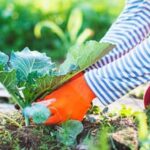Introduction
An ideal vegetable garden provides many benefits to both the gardener and their local ecology. Not only do active kitchen gardens promote a healthier lifestyle, they also provide a space for people to get outdoors and connect with nature. Gardeners can reap the rewards of fresh home-grown produce, reducing their environmental footprints and becoming more self-sufficient. Furthermore, by introducing something new into their environment, they can observe what plants thrive in the local climate and attract native wildlife. Community education initiatives are often undertaken as part of gardening projects, helping introduce people to important concepts of sustainable living. With an ideal vegetable garden setting the foundation for this type of sustainability, individuals from any age or background have the ability to take part in creating environmentally friendly spaces without having to break the bank. All that’s needed is some effort, curiosity and creativity – skills that are invaluable when it comes to greener lifestyles.
List of the Most Popular Vegetables to Plant in a Garden
Tomatoes: One of the most popular vegetables to plant in a garden due to their versatility and potential for high yields. Tomatoes can be used in many dishes, from salads to sauces and are especially delicious when eaten freshly picked from your own garden. Plant tomatoes two weeks after the last frost of the season to give them enough time to mature throughout the summer months. They should be spaced about 18-24 inches apart, with stakes or cages for support as needed.
Carrots: Carrots are a cool-season vegetable that should be planted as soon possible in early spring. They prefer cooler temperatures, so it is best to wait until after the danger of frost has passed to ensure successful seed germination. Carrot seeds tends to spread outward quite a bit, so they should be planted 1/2 inch deep and approximately 2 inches apart. For convenience, you may want to consider planting carrots in rows with 4 inch row widths and 12-18 inch spaces between rows. They’ll take anywhere from 40-70 days from sowing until harvest time depending on variety.
Lettuce: Lettuce is an incredibly easy plant for novice vegetable gardeners that prefers cooler temperatures for growth and definitely needs protection from heat and direct sunlight during summer months. Lettuce seeds can be sown directly outdoors or started indoors in flats or small containers 6–8 weeks before last frost (or later). Sow lettuce seeds every week or two up until mid-summer, spacing them thicknesses 1/4–1/2 inch apart in rows 8–12 inches apart – this will allow you to have fresh lettuce ready at any given time! The mature plants can then be harvested shortly afterward by cutting off entire heads at soil level with a sharp knife or scissors just above the root crown where new leaves will continue growing rapidly soon after.
Types of Varieties to Choose From For Optimal Yields
When deciding on the best varieties of vegetables to plant in an ideal garden, one should consider both their local climate and soil conditions as well as personal tastes. A garden planted with robust, disease-resistant varieties that are well-suited to the local soil type will yield a plentiful harvest. Some key considerations when selecting varieties include temperature tolerance, harvest period lengths and optimal use of space. For hot climates, some heat-tolerant varieties like certain types of peppers, eggplants and tomatoes would produce better yields than those not designed for these warmer conditions. For cold climates, select hearty cold-weather veggies like broccoli and kale that can withstand cooler temperatures with ease. Additionally, choosing short or bush varieties of plants like onions and peppers is a great way to maximize yields per square foot in smaller gardens. Lastly, picking the right length of harvesting period for each vegetable type is important too; this ensures that harvests can be stretched throughout the entire season without any periods of overproduction or gaps in supply.
Preparation Tips
When planting a vegetable garden, you should use nutrient-rich soil that is well-drained. If your soil is too clay-like, it can make it difficult for roots to penetrate and limit the amount of air and nutrients available for the growth of plants. To create ideal conditions, start by digging up your soil and mixing it with generous amounts of organic matter such as compost or aged manure before planting. This will help improve the overall quality and structure of your soil so that its capacity to support sustainable plant life is maximized. Additionally, it’s important to test the acidity of your soil prior to planting so that you can create the ideal environment for growing vegetables according to their specific needs. Be sure to regularly add organic matter throughout the season as it’s an important source of essential nutrients for healthy growth and fruiting in many vegetables.
Planting Strategies
Timing: Timing is an important factor when planting your vegetable garden, as the right choice can make a huge difference in how successful your garden will be. Planting should occur early enough in the season that the plants have ample time to establish themselves and to reach maturity before cooler temperatures arrive. It is also best to stagger the planting of crops so that you have more consistent harvests throughout the growing season.
Spacing: Spacing is also important for vegetable gardens, as crowding can lead to diseases and pests becoming an issue. Generally speaking, it is recommended that you maintain a spacing range of 8-18 inches between plants for larger crops such as tomatoes, peppers, and broccoli. For smaller crops such as lettuce and carrots, 4-6 inches should be sufficient. It is also important to plan for staggered plantings to further avoid overcrowding when possible.
Planting Depth: The depth at which each seed or plant should be planted is another key factor in setting up a successful garden. Generally speaking, sowing seeds at twice their width (or size) should achieve adequate depth with consistent watering into consideration afterwards. Seeds of larger sizes may require deeper planting depths than this general rule provides with as much as 3-4 times their size used if necessary to get satisfactory results with germination and growth over time.
Water Requirements
Watering your garden is essential for vegetable growth. Knowing when and how often to water your vegetables is key to success. In general, vegetable gardens should be watered deeply once a week to ensure that the soil is thoroughly saturated. If rainfall has consistently been light, then watering more than once a week may be necessary.
How deep you water depends on the type of vegetables you are growing; if the vegetables have deeper root systems, then you need to make sure that the water reaches beyond 12 inches into the soil for them to adequately drink it in. For shallower rooted vegetables, like tomatoes or peppers, 6-8 inches should suffice. Soaker hoses and drip irrigation systems are great options for ensuring that all plants in a garden receive enough water without requiring too much manual labor like having to move around soaking hoses every day.
Using mulch can also help reduce evaporation, as well as keep weeds away which will help conserve water naturally by reducing competition between your plants and weeds for it! Additionally, timing your watering is important because if you avoid watering in the middle of the day during its hottest period (instead at dawn or dusk) conserves moisture so there’s little waste from sun converting whatever liquid falls from the sky into vapor before it gets soaked up by surrounding vegetation. Lastly, pay attention to changes in temperature or humidity that might require you need to adjust how much and often you should be watering your garden this season!
Harnessing Technology
When it comes to creating an ideal vegetable garden, technology can be the farmer’s best friend. Technology can make a huge difference in helping farmers plant and maintain their gardens with precision and accuracy. For example, modern GPS-based technology can be used to precisely position beds and other fixtures in a garden. This makes it easier for farmers to place vegetables in the most optimal areas of their gardens where they will receive adequate sun and water while maximizing yields.
Furthermore, digital sensors placed in the soil can continuously provide gardeners with detailed information on soil moisture levels, pH levels, mineral content, temperature, and other important factors that are essential for planting and maintaining a successful vegetable garden. With this data, farmers can adjust their fertilizers and irrigation practices to ensure optimum growing conditions for their crops. In addition to digital datasets, drones equipped with high resolution cameras can be used to monitor vegetation health from overhead by taking aerial photographs which help identifying problems in crops before they become too severe.
Using modern technology also makes it much easier for farmers to track progress throughout the season such as pest or disease damage affecting crop production – giving them timely notice about potential risks so preventive measures may be taken before damage is done. This helps ensure that weekly harvests yield high-quality products without having to worry about illness or loss during the growth process – enabling an ideal vegetable garden planting experience every time!
Maintenance Suggestions
To ensure your vegetable garden remains productive, healthy and flourishing throughout the season, there are a few maintenance suggestions you should follow. Firstly, you should make sure to keep your plants adequately watered. Even though some vegetables can tolerate short periods of drought, the most common problem among home gardeners is overwatering. Be sure to check the moisture level in the soil prior to watering and only water if it’s necessary. Secondly, don’t forget to fertilize your plants! Vegetables require lots of nutrients for them to thrive and produce well so adding a slow-release fertilizer every month or two will help supply those needs. Finally, practice good garden hygiene. Remove any signs of disease on your vegetables, such as wilted leaves or spots on the fruit, right away to prevent it from spreading. Additionally, remove weeds frequently as they can attract insects and diseases which could harm the other plants in the area. By following these maintenance suggestions closely you can be sure that your vegetable garden remains productive and flourishing all season long!
Closing
Growing your own vegetable garden is an enjoyable and satisfying experience. Not only can it provide fresh, nutrient-rich food for your family, but it’s also a great way to relax and take in nature around you. There are endless options when it comes to the types of vegetables you can grow, giving you even more motivation to start a garden! You’ll also appreciate how convenient it is to have a steady supply of fresh produce right outside your door. Plus, growing your own vegetables means you know exactly what has gone into the soil and that no harsh pesticides or chemicals will be used – something that helps keep both you and the environment healthy. Another major benefit of vegetable gardening is the physical activity involved; research suggests spending time in nature burns calories, reduces stress levels and overall increases well-being. So if you’re looking for ways to improve your health, having a vegetable garden could be just what you need! Gardening can even become an opportunity for creative expression as soon as those plants start blooming. When all is said and done, growing your own vegetables in a garden offers many reasons why people love it – good for both body, soul and wallet!

If you’re looking to get into vegetable gardening, or are just looking for some tips on how to make your current garden better, then you’ve come to the right place! My name is Ethel and I have been gardening for years. In this blog, I’m going to share with you some of my best tips on how to create a successful vegetable garden.





